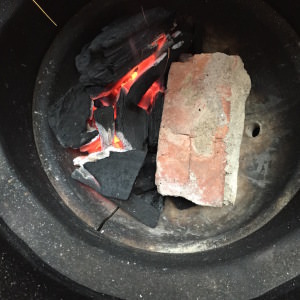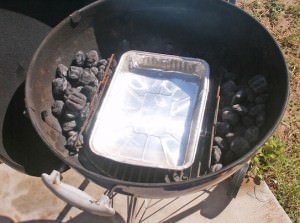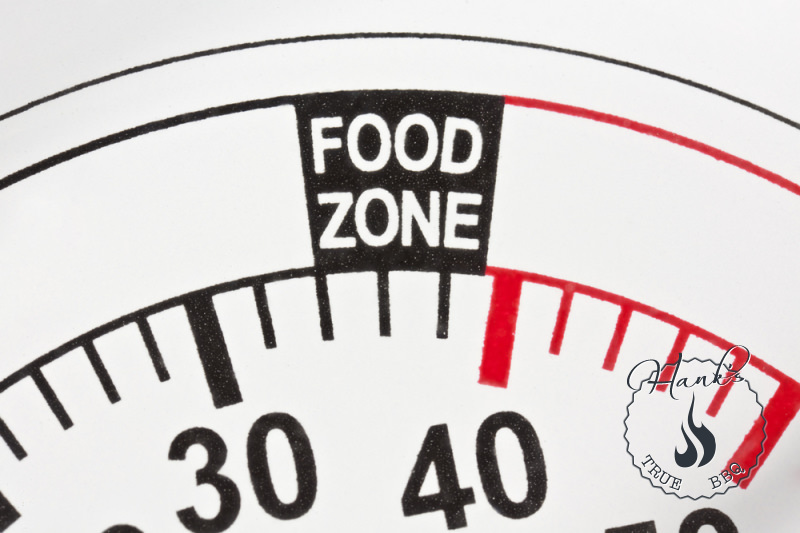Temperature control is the number one thing you must master to succeed when grilling. When using the stove or oven you wouldn’t cook at random temperatures, varying +-50° F, right? So why do it when grilling?
So, how on earth is that done, you might ask. Once the fire is burning, it is kinda hard to choke it, isn’t it? Well, there are several ways to accomplish that. Fire needs three things to exist:
- oxygen (air)
- fuel (charcoal or briquettes)
- heat (the matches or lighter at first, then it is self-sustained)
Adjust airflow
The most obvious thing to do is reduce airflow. This works really well, provided you are using a grill that has a lid. Put the lid on, and adjust airflow using both the bottom and top vents. You regulate airflow coming in using the bottom vent, the top vent regulates the exhaust. So, which one should you use? The basic recommendation is to set the bottom vent to half open, and adjust airflow using the top vent. The reason is that if air can’t get out, then air won’t get in either. Remember, air isn’t pushed in, it is sucked in due to the slight vacuum created by hot air exiting through the top vent. Experiment and see what works best for your grill.
Adjust fuel
This is where you get the most leverage. If your fuel supply is limited, the fire can only get so hot. This is the most important thing to get right. A simple way is to place coal or briquettes on one side of the grill, instead of filling up as usual.

Except for that there are two common ways to reduce the amount of fuel that is on fire: The snake method, and the Minion method. The latter is used as part of the snake method. The Minion method (named after Jim Minion) simply means that you light up just a few coals or briquettes using a chimney starter, and when they are ashed over you place them on the unlit coals. This way only a few coals or briquettes are lit at one time. This means lower heat, but it also means that the fire will last longer, as it will spreads slowly from coal to coal instead of all of them burning at once. This is the domino effect, applied to charcoal.
The Minion method
Fill your grill with coal or briquettes as usual. Place 4-5 coals or briquettes in a chimney starter. When starting just a few coals it is best to turn the chimney upside down. Light them with some newspaper, and let them burn until they start to ash, or ash over completely if using briquettes. Place them on the unlit coals in the grill, and close the lid. Wait 10-20 minutes for the temperature to settle.
Coal or briquettes?
The short answer is: it’s up to your preferences, and your grill. Neither one is better in an absolute comparison. The obvious differences are two:
- Coals get started quicker, which means you can start cooking sooner.
- Briquettes last a lot longer, which typically means you don’t need to refill.
When cooking low n’ slow you would think that briquettes are the obvious choice, but not necessarily. That depends on your grill. If you have a kettle grill, I would always use briquettes, as it is made of sheet metal (no insulation which means it is sensitive to wind and rain), and it leaks a bit of air (excluding the vents) which makes it a bit tricky to regulate. If you use a kamado grill (ceramic, insulated) which holds temperatures a lot better and therefore consumes less fuel, I would use always use (hardwood) coals.
Can I mix?
Yes, of course. It is common to use charcoal to get the briquettes started.
The Water pan
It is common when grilling low n’ slow to use a water pan in the grill. You may wonder what water is doing in a grill, but it is very convenient. Water is very good at transporting heat. If the water is cold, it will get warmed up when placed in a grill. If the temperature around it drops, heat will start to dissipate from the body of water, thereby effectively evening out temperature spikes. Another benefit is that the water will slowly dissipate, creating a moist environment, which is desirable when grilling for many hours.

All you have to do is use a common aluminum pan or metal bowl filled with hot water, and check it once an hour to see if you need to refill. The water pan is great for using as a divider if you’re using the Snake method.
When should I not use a water pan?
I would say: in a kamado grill. It creates such a moist environment in itself that the water pan is superfluous. But if you’re using a kettle grill, offset smoker or cabinet smoker the water pan is of great help.
What’s the big difference?
Running at the correct cooking temperature guarantees you a better result in the form of well cooked meat that is still moist and tender.

